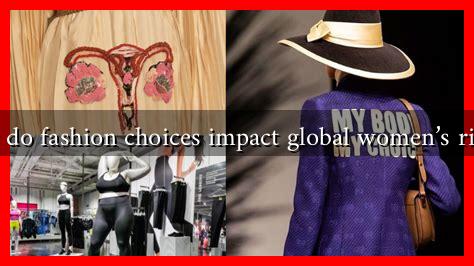-
Table of Contents
How Do Fashion Choices Impact Global Women’s Rights?
Fashion is often seen as a form of self-expression, a way to showcase individuality and creativity. However, the choices women make in their clothing can have far-reaching implications that extend beyond personal style. Fashion choices can influence global women’s rights, shaping perceptions, challenging stereotypes, and even driving social change. This article explores the intricate relationship between fashion and women’s rights, highlighting how clothing can serve as a powerful tool for empowerment and activism.
The Power of Clothing as a Statement
Clothing is not just about aesthetics; it carries cultural, social, and political significance. Women’s fashion choices can challenge societal norms and advocate for rights in various ways:
- Symbol of Resistance: In many cultures, clothing can symbolize resistance against oppressive regimes. For instance, the hijab has been both a symbol of faith and a point of contention in discussions about women’s rights in countries like Iran.
- Fashion as Protest: Movements like the Women’s March have utilized fashion to convey messages of solidarity and resistance. The iconic pink “pussy hats” worn during the marches became a symbol of the fight for women’s rights.
- Empowerment through Choice: The ability to choose what to wear is a fundamental aspect of personal freedom. In societies where women are restricted in their clothing choices, advocating for fashion freedom can be a step towards broader gender equality.
Case Studies: Fashion and Women’s Rights Movements
Several case studies illustrate how fashion has been intertwined with women’s rights movements across the globe:
- The Suffragette Movement: In the early 20th century, suffragettes in the UK and the US used fashion to make statements about their fight for the right to vote. They wore white dresses to symbolize purity and used colors like purple, green, and white to represent their cause.
- Afghan Women’s Fashion: After the fall of the Taliban, Afghan women began to reclaim their identities through fashion. The resurgence of colorful traditional clothing has become a symbol of freedom and empowerment.
- Fashion for All: Brands like Aerie and Savage X Fenty have embraced body positivity and inclusivity, promoting diverse representations of women in their campaigns. This shift in fashion not only empowers women but also challenges societal beauty standards.
The Economic Impact of Fashion Choices
Fashion choices also have significant economic implications for women’s rights globally. The fashion industry is a multi-billion dollar sector that employs millions of women worldwide. However, the conditions under which these women work often raise ethical concerns:
- Labor Rights: Many women in developing countries work in garment factories under poor conditions. Advocating for fair wages and safe working environments is crucial for advancing women’s rights in these regions.
- Supporting Women-Owned Brands: Choosing to support women-owned fashion brands can empower female entrepreneurs and contribute to economic independence.
- Sustainable Fashion: The rise of sustainable fashion has opened discussions about ethical consumption. Women are increasingly making choices that reflect their values, promoting environmental sustainability and social justice.
Statistics and Trends
Understanding the impact of fashion on women’s rights can be further illustrated through statistics:
- According to the World Bank, women make up 60-70% of the garment workforce in developing countries.
- A report by McKinsey & Company found that the global fashion industry could add $2.5 trillion to the economy by 2030 if it embraces inclusivity and diversity.
- Research shows that brands that promote body positivity see a 20% increase in customer loyalty among women.
Conclusion: Fashion as a Catalyst for Change
Fashion choices are more than just personal preferences; they are powerful statements that can influence global women’s rights. From serving as symbols of resistance to driving economic empowerment, clothing has the potential to challenge societal norms and advocate for change. As consumers, women can leverage their fashion choices to support ethical brands, promote inclusivity, and stand in solidarity with movements advocating for women’s rights worldwide. By recognizing the impact of fashion, we can harness its power to create a more equitable world for women everywhere.
For further reading on the intersection of fashion and women’s rights, consider exploring resources from organizations like UN Women and Fashion Revolution.

